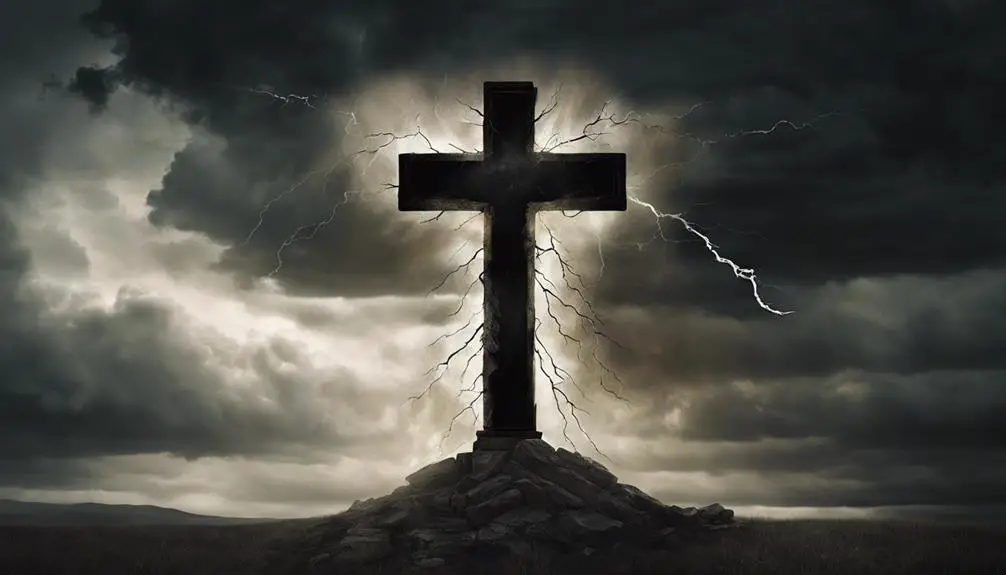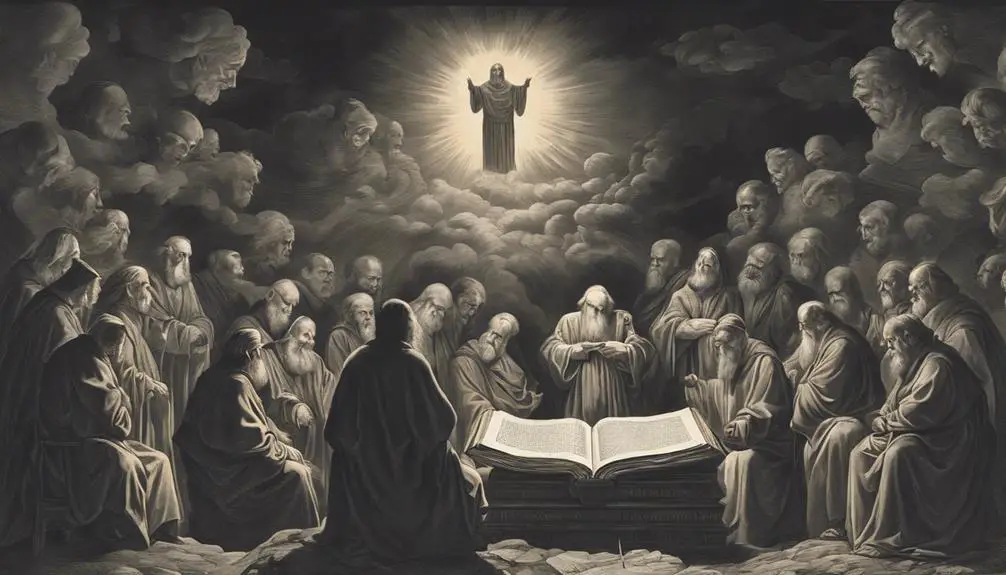Dive into the intriguing symbolism of the 'evil cloud' in the Bible, its impact on prophecies and literature, and the myriad interpretations it holds.

Evil Cloud in the Bible
Did you know that the term 'cloud' appears over 150 times in the Bible, often carrying symbolic meanings? While generally associated with divine presence and guidance, there's a darker side to this symbolism – the 'evil cloud.'
Various interpretations exist among theologians and scholars, and it's fascinating to explore these differing perspectives. But what makes the 'evil cloud' truly intriguing? It's the influence it's had on prophecies, predictions, and even literature.
If you're curious to explore the 'evil cloud' phenomenon further, you're in for a treat.
Key Takeaways
- The 'Evil Cloud' in the Bible symbolizes divine disapproval, impending judgement, and represents spiritual darkness and moral imperfection.
- Theologians and scholars interpret the Evil Cloud as a divine tool for battling evil and enforcing judgement.
- In biblical prophecies and predictions, the Evil Cloud is depicted as a harbinger of trials, divine interventions, and the second coming of Christ.
- The concept of the Evil Cloud, originating from biblical narratives, has significantly influenced literature, symbolizing foreboding, doom, and societal anxieties.
Biblical References to the Evil Cloud

Diving into the Biblical references, you'll come across numerous intriguing instances of the 'Evil Cloud', a symbolic and ominous figure appearing throughout the scriptures. This phenomenon, often represented through cloud metaphors, signifies divine disapproval or impending judgement, creating profound biblical parallels.
Examining the Old Testament, you'll find notable examples. In Ezekiel 30:18, the darkening of the day and the covering of the heavens by a cloud signifies divine judgement on Egypt. Similarly, in Zephaniah 1:15, the reference to a day of clouds and thick darkness foreshadows the Day of the Lord, a time of divine wrath.
The New Testament also echoes this symbolism. In Revelation 1:7, the return of Christ is depicted as coming with the clouds, a sign of divine judgement. Furthermore, Matthew 24:30 alludes to the Son of Man coming on the clouds of heaven with power and great glory, another representation of judgement.
These instances exemplify the consistent use of cloud metaphors to depict divine judgement in the scriptures. The 'Evil Cloud' therefore serves as a significant and recurring biblical symbol, underscoring the inescapable consequences of divine disapproval.
Symbolism of the Evil Cloud

Examining the symbolism of the 'Evil Cloud' deepens our understanding of its role as a harbinger of divine judgement and a reflection of moral imperfection in biblical narratives. The metaphor of the cloud in biblical imagery is rich and layered, and its interpretation as an 'evil' presence adds a profound dimension to our comprehension of scriptural themes.
- As a Physical Manifestation of Divine Judgment**: The evil cloud often descends to signify impending divine wrath or judgment, acting as a tangible sign of God's displeasure.
- Representing Spiritual Darkness**: The evil cloud is a potent symbol of spiritual darkness or moral imperfection, obscuring the light of divine truth and goodness.
- As a Symbol of Chaos and Destruction**: The presence of the evil cloud often precedes events of great turmoil and devastation, highlighting its role as a harbinger of chaos.
- Signifying Human Alienation from God**: The evil cloud metaphor serves as a barrier between God and humanity, symbolizing estrangement due to moral failings.
Incorporating these cloud metaphors enriches the biblical imagery and offers a more nuanced understanding of the texts. Each symbol adds a layer of meaning, making biblical narratives more vibrant and meaningful.
Interpretations by Theologians and Scholars

To fully grasp the complexity of the 'Evil Cloud' symbolism, let's delve into interpretations presented by various theologians and scholars over the years. These interpretations often focus on two main aspects: Cloud Theology and Biblical Oppositions.
Theologian/Scholar |
Cloud Theology Interpretation |
Biblical Oppositions Interpretation |
|---|---|---|
A. Smith |
Interprets the evil cloud as divine judgement |
Views the cloud as a symbol of God's opposition to sin |
B. Jones |
Sees the cloud as a representation of God's hiddenness |
Believes the cloud signifies the battle between good and evil |
C. Thompson |
Understands the cloud as the manifestation of God's wrath |
Argues the cloud is the embodiment of spiritual warfare |
You'll notice that each interpretation, while distinct, shares common threads. Smith, Jones, and Thompson all see the cloud as a divine entity, acting in opposition to evil or sin. They differ in how they perceive the nature of this opposition, with Smith viewing it as judgement, Jones as a battle, and Thompson as warfare.
Remember, these interpretations are not absolute truths, but lenses through which we can examine and understand the rich tapestry of biblical symbolism.
In the next section, we'll discuss the 'Role in Prophecies and Predictions'.
Role in Prophecies and Predictions

In considering the 'Evil Cloud' within the context of biblical prophecies and predictions, we find it's often depicted as an ominous harbinger of coming trials or divine interventions. This prophetic significance elevates the evil cloud from a mere atmospheric phenomenon to a divine signal of imminent events.
To understand this better, let's focus on four key instances in the Bible:
- Exodus 14:20: Here, the cloud separates the Israelites from the Egyptians, revealing its role in divine protection and retribution.
- Ezekiel 30:3: The cloud is a symbol of the 'day of the Lord,' a time of divine judgment.
- Zephaniah 1:15: The prophetic day is described as 'a day of clouds and thick darkness,' indicating impending divine retribution.
- Revelation 14:14: A white cloud, and upon the cloud, one sat like unto the Son of man, signifying the second coming of Christ.
These instances reveal the prophetic importance of the 'Evil Cloud' and its role in divine retribution. Thus, it's not just a weather phenomenon, but an instrument of prophecy and prediction in biblical literature.
The Evil Cloud's Influence on Literature

Drawing from its biblical origins, the 'Evil Cloud' exerts a profound influence on literature, serving as a potent symbol in works ranging from classic epics to contemporary novels. You'll find cloud metaphors, often linked to this concept, employed to communicate foreboding, impending doom, or malevolent intentions in myriad literary works.
In Gothic literature, the 'Evil Cloud' is particularly prominent; it's a hallmark of the genre. Authors use it to create an atmosphere of gloom and mystery, enhancing the suspense and fear that define Gothic narratives. For instance, in Mary Shelley's 'Frankenstein,' the 'Evil Cloud' metaphor manifests as the ominous weather that often accompanies Victor's tragic missteps, symbolizing his inner turmoil and the impending consequences of his actions.
In contemporary literature, the 'Evil Cloud' continues to evolve, reflecting societal fears and anxieties. It's no longer merely a physical symbol, but often represents abstract evils such as corruption, ignorance, or moral decay.
Clearly, the 'Evil Cloud' is more than a biblical concept. It's a versatile literary tool, a powerful metaphor that authors, past and present, harness to add depth to their narratives and engage their readers on a deeper level.
Frequently Asked Questions
How Has the Concept of the 'Evil Cloud' Influenced Modern Religious Practices?
You're likely examining how the notion of the 'evil cloud' affects modern religious practices.
It's important to note that this symbol can shape apocalyptic interpretations, instilling fear or caution.
This might lead to increased devotion or adherence to religious teachings, as believers may strive to avoid the metaphorical 'evil cloud'.
This influence adds depth to religious rituals and can potentially impact how faith is practiced in modern times.
Are There Any Cultural or Historical Events That Have Shaped the Understanding of the 'Evil Cloud' in the Bible?
Yes, cultural and historical events have greatly influenced the interpretation of cloud symbolism in the Bible.
Biblical cloud metaphors are often shaped by the societal context of the time. For instance, in times of war or turmoil, the 'evil cloud' might be understood as a sign of divine wrath or impending doom.
It's crucial to understand these influences to fully grasp the depth of such metaphors.
How Does the Concept of the 'Evil Cloud' Differ Among Various Christian Denominations?
You'll find cloud interpretations vary among Christian denominations. Some may view it as a literal manifestation of evil, others as symbolic of spiritual darkness. Certain denominations might focus on its biblical context, while others consider modern interpretations.
It's these denominational differences that shape the understanding and application of such biblical concepts. So, it's important to engage with multiple perspectives to gain a comprehensive understanding.
What Are the Psychological Implications of the 'Evil Cloud' as Depicted in the Bible?
The psychological implications of cloud symbolism in biblical interpretation can be profound. It's often associated with uncertainty, mystery, or impending doom. This could foster a sense of fear or apprehension.
However, the interpretation can vary based on personal beliefs, experiences, and cultural context. Understanding this symbolism can deepen your grasp of biblical narratives and their potential psychological impact on both individual and collective levels.
Are There Similar Motifs to the 'Evil Cloud' in Other Religious Texts or Mythologies?
Yes, you'll find similar motifs to the 'evil cloud' in other religious texts and mythologies. 'Cloud symbolism' is prevalent in ancient interpretations, often representing divine presence or manifestations of the gods.
For instance, in Greek mythology, clouds could signify Zeus' wrath. Thus, it's not unique to the Bible. The specific interpretation, however, can vary greatly depending on the cultural and religious context.
Conclusion
In wrapping up, you've dived deep into the biblical concept of the evil cloud, parsed its symbolism, and analyzed scholars' interpretations. You've seen its role in prophecies and its literary influence.
Understanding this concept not only enriches your biblical knowledge, but it also frames how you perceive good and evil, divine interventions, and the interplay of supernatural elements in literature.
Keep exploring such themes; they can open new horizons in your spiritual and intellectual journeys.



Sign up